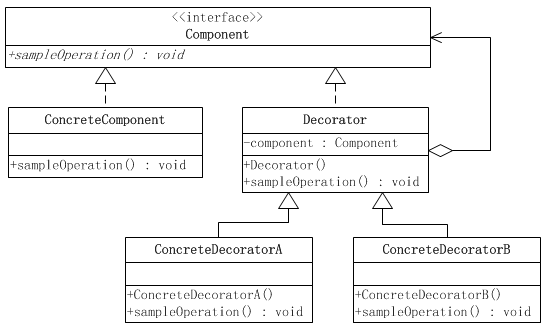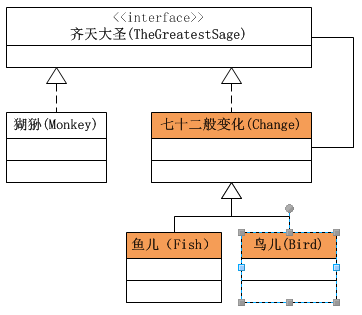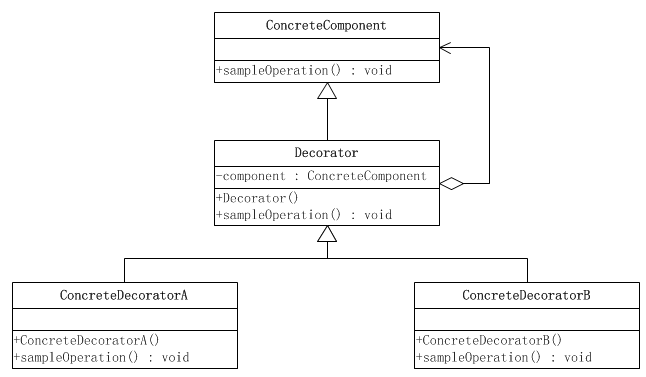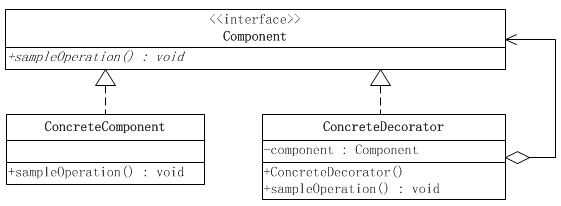在阎宏博士的《JAVA与模式》一书中开头是这样描述装饰(Decorator)模式的:
装饰模式又名包装(Wrapper)模式。装饰模式以对客户端透明的方式扩展对象的功能,是继承关系的一个替代方案。
装饰模式的类图如下:

涉及到的角色:
抽象构件(Component)角色:给出一个抽象接口,以规范接收附加责任的对象。
具体构件(ConcreteComponent)角色:定义一个接收附加责任的类。
装饰(Decorator)角色:持有一个构件(Component)对象的实例,并定义一个与抽象构件接口一致的接口。
具体装饰(ConcreteDecorator)角色:负责给构件对象“贴上”附加的责任。
抽象构件角色:
1 public interface Component { 2 3 public void sampleOperation(); 4 5 }
具体构件角色:
1 public class ConcreteComponent implements Component { 2 3 @Override 4 public void sampleOperation() { 5 // 写相关的业务代码 6 } 7 8 }
装饰角色:
1 public class Decorator implements Component{ 2 private Component component; 3 4 public Decorator(Component component){ 5 this.component = component; 6 } 7 8 @Override 9 public void sampleOperation() { 10 // 委派给构件 11 component.sampleOperation(); 12 } 13 14 }
具体装饰角色:
1 public class ConcreteDecoratorA extends Decorator { 2 3 public ConcreteDecoratorA(Component component) { 4 super(component); 5 } 6 7 @Override 8 public void sampleOperation() { 9 super.sampleOperation(); 10 // 写相关的业务代码 11 } 12 }
1 public class ConcreteDecoratorB extends Decorator { 2 3 public ConcreteDecoratorB(Component component) { 4 super(component); 5 } 6 7 @Override 8 public void sampleOperation() { 9 super.sampleOperation(); 10 // 写相关的业务代码 11 } 12 }
齐天大圣:
孙悟空有七十二变,他的每一种变化都给他带来一种附加的本领。他变成鱼儿时,就可以到水里游泳;他变成鸟儿时,就可以在天上飞行。
本例中,Component角色由齐天大圣扮演,ConcreteComponent角色属于大圣本尊即猢狲本人。Decorator角色由大圣的七十二变扮演,ConcreteDecorator角色是鱼儿、鸟儿等72种具体变化。

抽象构件角色齐天大圣接口:
1 //大圣的尊号 2 public interface TheGreatestSage { 3 4 public void move(); 5 }
具体构件角色大圣本尊猢狲类:
1 public class Monkey implements TheGreatestSage { 2 3 @Override 4 public void move() { 5 //代码 6 System.out.println("Monkey Move"); 7 } 8 9 }
抽象装饰角色七十二变:
1 public class Change implements TheGreatestSage { 2 private TheGreatestSage sage; 3 4 public Change(TheGreatestSage sage){ 5 this.sage = sage; 6 } 7 @Override 8 public void move() { 9 // 代码 10 sage.move(); 11 } 12 13 }
具体装饰角色鱼儿:
1 public class Fish extends Change { 2 3 public Fish(TheGreatestSage sage) { 4 super(sage); 5 } 6 7 @Override 8 public void move() { 9 // 代码 10 System.out.println("Fish Move"); 11 } 12 }
具体装饰角色鸟儿:
1 public class Bird extends Change { 2 3 public Bird(TheGreatestSage sage) { 4 super(sage); 5 } 6 7 @Override 8 public void move() { 9 // 代码 10 System.out.println("Bird Move"); 11 } 12 }
客户端:
1 public class Client { 2 3 public static void main(String[] args) { 4 TheGreatestSage sage = new Monkey(); 5 // 第一种写法 6 TheGreatestSage bird = new Bird(sage); 7 TheGreatestSage fish = new Fish(bird); 8 // 第二种写法 9 //TheGreatestSage fish = new Fish(new Bird(sage)); 10 fish.move(); 11 } 12 13 }
大圣本尊是ConcreteComponent类。鸟儿、鱼儿是装饰类,装饰的是大圣本尊即猢狲实例。把大圣从一只猢狲装饰成一只鸟儿(把鸟儿的功能加到猢狲上),然后又把鸟儿装饰成了一条鱼儿(把鱼儿的功能加到猢狲+鸟儿上,得到了猢狲+鸟儿+鱼儿)。

装饰模式的简化
如果只有一个ConcreteComponent类,可以去掉Component接口,把Decorator当成一个ConcreteComponent子类,见下图:

如果只有一个ConcreteDecorator类或者只有两个ConcreteDecorator类,可以把Decorator和ConcreteDecorator合并成一个类,见下图:

透明性的要求:
装饰模式对客户端的透明性要求程序不声明一个ConcreteComponent类型的变量,而要声明一个Component类型的变量。
用孙悟空的例子来说,必须把孙悟空的所有变化都当成孙悟空来对待。如果把孙悟空变成的鱼儿当成鱼儿,那就被孙悟空骗了。
正确做法:
1 TheGreatestSage sage = new Monkey(); 2 TheGreatestSage bird = new Bird(sage);
错误做法:
1 Monkey sage = new Monkey(); 2 Bird bird = new Bird(sage);
半透明的装饰模式:
装饰模式的目的是在不改变接口的前提下,增强类的性能。在增强性能时,需要创建新的公有方法。用孙悟空的例子来说:齐天大圣类没有飞行能力,而鸟儿有,所以鸟儿类里应该有一个新的fly方法。齐天大圣类没有游泳能力,而鱼儿有,所以鱼儿类里应该有一个新的swim方法。
装饰模式和适配器模式都是包装模式(Wrapper Pattern),通过封装其他对象达到目的。理想的装饰模式在对被装饰对象进行功能增强时,要求具体构件角色、装饰角色的接口与抽象构件角色的接口一致。适配器模式会改变源对象的接口,与目标接口一致。装饰模式有透明和半透明两种,区别在于装饰角色的接口与抽象构件角色的接口是否一致。透明的装饰模式即理想的装饰模式要求具体构件角色、装饰角色的接口与抽象构件角色的接口一致。如果装饰角色的接口比抽象构件角色的接口宽,装饰角色成了适配器角色,称为半透明的装饰模式,见下图:

适配器类的接口会比被装饰的目标类接口宽。
因此,大多数的装饰模式的实现都是半透明的。也就是说,允许装饰模式在具体装饰类里增加新的方法。用孙悟空的例子来说:
1 TheGreatestSage sage = new Monkey(); 2 Bird bird = new Bird(sage); 3 bird.fly();
装饰模式的优点:
1 装饰模式与继承的目的都是扩展对象的功能,但装饰模式更灵活。装饰模式允许动态决定“贴上”一个需要的“装饰”或者除掉一个不需要的“装饰”,而继承是静态的。
2 具体装饰类的不同组合可以构造出不同行为的组合。
装饰模式的缺点:
装饰模式比继承需要更少的类,但是装饰模式比继承产生更多的对象,会使查错变得困难。
参考资料